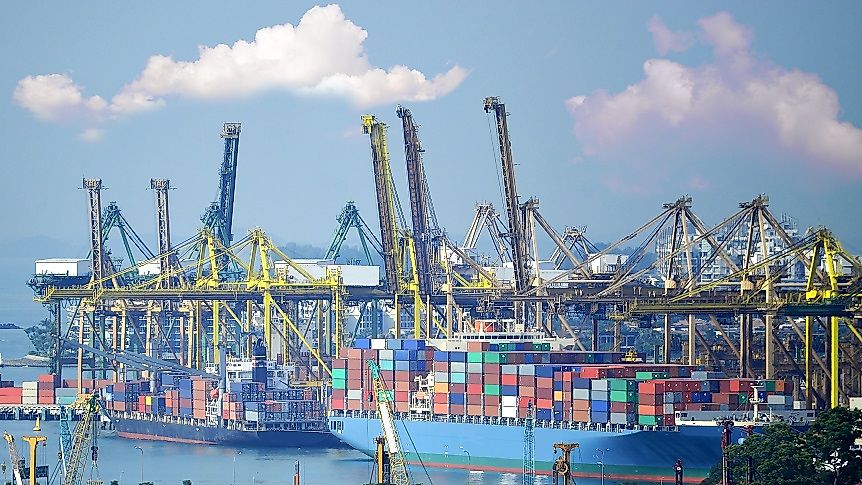15 Countries With The Most Export-Driven Economies

Export oriented Industrialization was adapted by many countries when the "Four Asian Tigers" (Hong Kong, Singapore, South Korea, and Taiwan) rose to economic prominence as a result of their export economies. Manufactured goods were the basis for the success of these "Four Asian Tigers". However today, for this strategy to work, that country must have a diversified export in goods and services that could successfully and cheaply compete with industrialized economies. The main reason why developing countries prefer this strategy are the subsidies that their industries could get from the government. Another is the access permitted to local markets.
The Long-Lasting Economic Benefits of Export-Driven Economies
In these parts of the globe, producing goods and services for consumers abroad keeps their economies humming. This may well be true as export oriented economies make profits and allow the trigger effect which affects productivity and in turn supports more exports. As long as there is a ready market for these products, export oriented economies can keep on humming. Hong Kong and its exports of goods and services add up to 219.6% relative to its Gross Domestic Product. Among its exports, electronic equipment tops the list with gems, precious metals, machines, medical equipment, and clothing going down the list. Luxembourg's exports accounted for 203.3% of its GDP with exports of financial services. It also exports steel, chemical, rubber, and glass. Singapore comes in at 187.6% with its top export of electronic equipment, machinery, oil, chemicals, and medical equipment. Ireland's exports accounted for 113.7% of its GDP with exports of machinery, computers, chemicals, medical devices, and animal products. Maldives comes in at 108.2% with its exports of fish, engines, and scrap metal. Macao's exports accounted for 99.1% of its GDP with its exports of clothing, textiles, footwear, toys, and electronics. United Arab Emirates comes in at 98.0% with its exports of Crude oil, natural gas, and dates. Equatorial Guinea comes in at 95.6% with its exports of oil, gas, cocoa, coffee, and timber. Slovakia's exports accounted for 91.9% of its GDP with its exports of machinery, electrical equipment, oil, vehicle parts, and computers. Hungary comes in at 89.3% with its exports of minerals, electronics, chemicals, and vehicles. Vietnam's exports accounted for 86.4% of its GDP with exports of oil, electronics, clothes, and shoes. Belgium's exports accounted for 84.0% of its GDP with exports of diamonds, metals, chemicals, and machinery. Estonia's exports accounted for 83.9% of its GDP with exports of furniture, machinery, metals, and foodstuff. Czech Republic's exports accounted for 83.8% of its GDP with exports of machinery, transport equipment, raw materials and fuel. Seychelles' exports accounted for 83.1% of its GDP with exports of fish, copra, cinnamon, and petroleum products.
Risks of Export Oriented Industrialization
Economists and other experts have repeatedly criticized export-oriented industrialization (EOI) as a strategy. One downside is that EOI may not benefit the economy if the prices of its exports do not exceed its import costs. Another negative aspect is the excessive dependence that a country has on its export specialization which would undermine the benefits if prices drop for those specializations. Product diversity is another reason why EOI failed in the 1997 Asian financial crisis. These countries used comparative advantage to maximize the benefits of EOI. The example of the "Four Asian Tiger" economies, namely Hong Kong, Singapore, South Korea, and Taiwan, could be taken as an exception. After World War II, the four countries benefited from a peculiar condition at that point in history. These countries were given the opportunity to get into the lower end of the Japanese manufacturing value chain as Japan was previously given preferential entry to European and US markets.
15 Countries With The Most Export-Driven Economies
| Rank | Country | Exports of Goods and Services expressed as a % of GDP |
|---|---|---|
| 1 | Hong Kong | 219.6% |
| 2 | Luxembourg | 203.3% |
| 3 | Singapore | 187.6% |
| 4 | Ireland | 113.7% |
| 5 | Maldives | 108.2% |
| 6 | Macao | 99.1% |
| 7 | United Arab Emirates | 98.0% |
| 8 | Equatorial Guinea | 95.6% |
| 9 | Slovakia | 91.9% |
| 10 | Hungary | 89.3% |
| 11 | Vietnam | 86.4% |
| 12 | Belgium | 84.0% |
| 13 | Estonia | 83.9% |
| 14 | Czech Republic | 83.8% |
| 15 | Seychelles | 83.1% |











